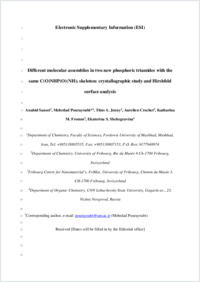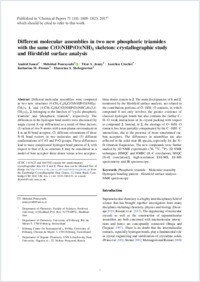Different molecular assemblies in two new phosphoric triamides with the same C(O)NHP(O)(NH)2 skeleton: crystallographic study and Hirshfeld surface analysis
- Saneei, Anahid Department of Chemistry, Faculty of Sciences, Ferdowsi University of Mashhad, Iran
- Pourayoubi, Mehrdad Department of Chemistry, Faculty of Sciences, Ferdowsi University of Mashhad, Iran
- Jenny, Titus A. Department of Chemistry, University of Fribourg, Switzerland
- Crochet, Aurélien Fribourg Centre for Nanomaterials, FriMat, University of Fribourg, Switzerland
- Fromm, Katharina M. Fribourg Centre for Nanomaterials, FriMat, University of Fribourg, Switzerland
- Shchegravina, Ekaterina S. Department of Organic Chemistry, UNN Lobachevsky State University, Nizhny Novgorod, Russia
-
01.10.2017
Published in:
- Chemical Papers. - 2017, vol. 71, no. 10, p. 1809–1823
English
Different molecular assemblies were compared in two new structures [4-CH3-C6H4C(O)NH]P(O)[NH]2(CH2)3, 1, and [4-CH3-C6H4C(O)NH]P(O)[NHC6H3(3,4-CH3)2]2, 2, belonging to the families of “cyclic phosphoric triamide” and “phosphoric triamide”, respectively. The differences in the hydrogen bond motifs were discussed (by single crystal X-ray diffraction) as a result of three factors: (1) action of two N atoms with a non-planar environment in 1 as an H-bond acceptor, (2) different orientations of three N–H bond vectors in two molecules and (3) different conformations of C=O and P=O groups. These differences lead to more complicated hydrogen bond pattern of 1, with respect to that of 2, as structure 1 may be considered as a model of four-acceptor–three-donor versus a two-acceptor–three-donor system in 2. The main discrepancies of 1 and 2, monitored by the Hirshfeld surface analysis, are related to the contribution portions of O···H/H···O contacts, in which compound 1 not only involves the greater existence of classical hydrogen bonds but also contains the further C–H···O weak interactions in its crystal packing with respect to compound 2. Instead, in 2, the shortage of O···H/H···O contacts has been partially compensated by the C···H/H···C interactions, due to the presence of more unsaturated carbon acceptors. The differences in assemblies are also reflected in the solid-state IR spectra, especially for the N–H vibration frequencies. The new compounds were further studied by 1D NMR experiments (1H, 13C, 31P), 2D NMR techniques [HMQC and HMBC (H–C correlation), HSQC (N–H correlation)], high-resolution ESI–MS, EI–MS spectrometry and IR spectroscopy.
- Faculty
- Faculté des sciences et de médecine
- Department
- Département de Chimie
- Language
-
- English
- Classification
- Chemistry
- License
-
License undefined
- Identifiers
-
- RERO DOC 306407
- DOI 10.1007/s11696-017-0168-x
- Persistent URL
- https://folia.unifr.ch/unifr/documents/306175
Other files
Statistics
Document views: 113
File downloads:
- Supplementary material: 123
- pdf: 236

